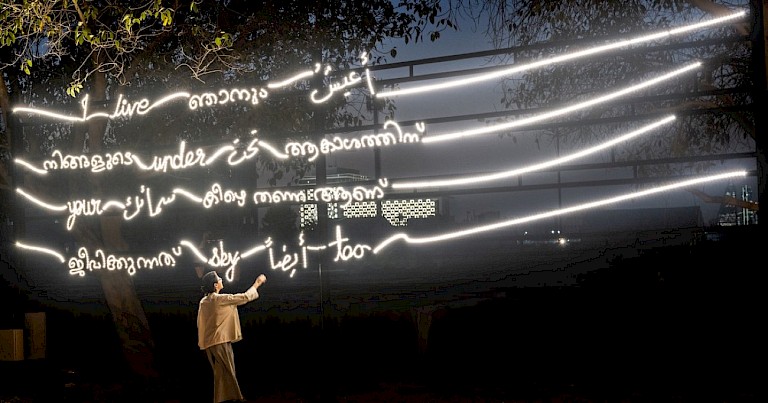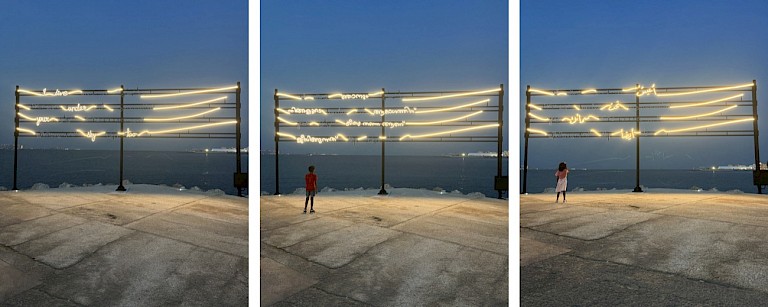



The Artist
Shilpa Gupta (b. 1976) is a Mumbai-based artist who studied sculpture at the Sir J.J. School of Fine Arts from 1992 to 1997. She has held solo exhibitions at prestigious venues worldwide, including the Contemporary Arts Center in Cincinnati, Arnolfini in Bristol, and the Museum of Contemporary Art in Antwerp (2021).
Gupta's work has been featured in renowned institutions like Tate Modern, Museum of Modern Art, and Solomon R. Guggenheim Museum. She has participated in major biennales such as the Venice Biennale (2019), Kochi Muziris Biennale (2018), and Berlin Biennale (2014), among others.
Her pieces are part of esteemed collections including Tate, Solomon R. Guggenheim Museum, and Centre Georges Pompidou. In 2022, she co-edited 'For, In Your Tongue, I Cannot Fit', an anthology addressing power dynamics. Additionally, Gupta released 'Artivities' in 2021, a compilation of art activities for youth.
Gupta's upcoming exhibitions include a duo solo with Marisa Merz at MAXXI – National Museum of 21st Century (curated by Bartolomeo Pietromarchi and Fanny Borel until September 2023), a solo at the Amant Art Center (curated by Ruth Estévez in October 2023), and another at the Tanya Bonakdar Gallery in New York. In 2024, she will exhibit at Centro Botín in Santander (curated by Bárbara Rodríguez Muñoz).
The development process of "I Live Under Your Sky" in Doha was a meticulous and collaborative effort that spanned several stages, involving not only Shilpa Gupta but also a team of professionals, cultural institutions, and local communities. Here's an overview of the key steps and considerations that contributed to the successful realization of this impactful art installation:
Conceptualization:
The project's journey began with the conceptualization phase, where Shilpa Gupta conceived the idea of creating an art installation that would explore themes of identity, borders, and shared humanity. The concept aimed to transcend cultural and linguistic boundaries, resonating with viewers regardless of their backgrounds.
Research and Cultural Sensitivity:
Gupta and her team conducted extensive research to ensure cultural sensitivity and relevance to the local context in Doha. This included an understanding of the city's diverse population, its unique cultural tapestry, and its position as a global hub for dialogue and exchange.
Collaboration and Partnerships:
Collaborations were key to the project's development. Gupta collaborated with local cultural institutions, galleries, and curators who provided valuable insights and support throughout the process. These partnerships facilitated access to resources, venues, and expertise.
Artistic Execution:
The actual creation of the installation involved meticulous craftsmanship. Each translucent and reflective object representing different countries required careful attention to detail. The choice of materials, colors, and sizes was made with the intention of creating a visually striking and emotionally evocative experience for viewers.
Site Selection:
The selection of the exhibition site within Doha was a crucial decision. The chosen location needed to be accessible to a diverse audience and capable of accommodating the installation's scale. This consideration also aligned with the project's aim to engage with the local community.
Community Engagement:
The project's development process incorporated community engagement initiatives. Gupta and her team organized workshops, discussions, and outreach programs to involve local residents in the art-making process and to gather personal stories and perspectives related to identity and borders.
Multidimensional Engagement:
"I Live Under Your Sky" extended beyond the physical art installation. It encompassed a series of events, discussions, and educational programs that deepened the audience's connection to the artwork. These engagements encouraged participants to reflect on the installation's themes and how they related to their own lives.
Impact Assessment:
Throughout the development process, continuous evaluation and impact assessment took place. Feedback from the community and participants in the project's various activities played a crucial role in refining the project's messaging and impact.
Public Awareness and Outreach:
Effective communication and outreach strategies were employed to raise public awareness about the project. Social media, press releases, and partnerships with local media outlets were leveraged to reach a wider audience.
In conclusion, the development process of "I Live Under Your Sky" in Doha was characterized by careful planning, collaboration, community engagement, and a deep commitment to exploring themes of identity and borders. Through a holistic approach that extended beyond the physical artwork, the project successfully engaged with the local population and left a lasting impact on the cultural landscape of Doha.
Shilpa Gupta's artworks stand as powerful testaments to the potential of art to challenge the status quo, delve deep into socio-political intricacies, and evoke profound introspection among viewers. "I Live Under Your Sky Too" epitomizes this, serving as a mirror to a world bound by borders and identities, yet echoing the universality of human experiences.
The resonance of "I Live Under Your Sky Too" with contemporary society is undeniable. Drawing insights from its title and thematic undertones, it's evident that the artwork grapples with the pressing global issues of nationalism, migration, and human rights. At a time when the world is confronting border disputes, grappling with the aftermaths of refugee crises, and navigating the intricate maze of identity politics, Gupta's artwork emerges as a poignant reminder. It highlights the shared humanity that underpins our existence, emphasizing the often-overlooked artificiality of the borders and divisions that separate us.
Moreover, Gupta has a unique ability to foster intercultural dialogues through her art. "I Live Under Your Sky Too" serves not just as a visual masterpiece but also as an invitation—a call for viewers to step out of their cultural or nationalistic bubbles. By engaging with her work, one is nudged to reflect on the broader concept of global citizenship, fostering a sense of empathy and understanding towards narratives and lives that might be drastically different from one's own. In a world that's increasingly divided, the importance of such artistic endeavors that bridge these divides can't be overstated.
Gupta's boldness in challenging artistic conventions is another facet that adds depth to her creations. She recognizes that art transcends mere aesthetics—it's a platform for messages, dialogues, and reflections. With "I Live Under Your Sky Too", Gupta pushes the envelope of traditional art forms by seamlessly marrying technology and interactive elements with moving narratives. In doing so, she not only challenges her contemporaries to rethink what art can achieve but also propels the entire art community into a new realm of possibilities.
Gupta's art also stands as a beacon of empowerment, especially for those who often find their voices muffled in the cacophony of mainstream narratives. Whether it's marginalized communities, individuals pushed to the fringes, or those rendered voiceless by societal constructs, Gupta's pieces amplify their stories. "I Live Under Your Sky Too" potentially serves as a platform where tales of alienation and marginalization—caused by all kinds of borders—are brought to the fore.
Her profound influence on contemporary artists is undeniable. Gupta's groundbreaking techniques, themes, and methods inspire, guiding both her peers and the next generation of artists. Her works, including "I Live Under Your Sky Too", lay down pathways for others to tread, encouraging them to explore resonant themes or weave in interdisciplinary methods.
Shilpa Gupta's artistic endeavors reverberate deeply within the art world and society at large. Her commitment to challenging boundaries, both thematic and medium-centric, transforms her artworks into more than mere visual treats. They become catalysts—spurring dialogues, reflections, and shifts in perception. For a more contemporary analysis, diving into recent art critiques, exhibition reviews, or academic pieces would be beneficial.


